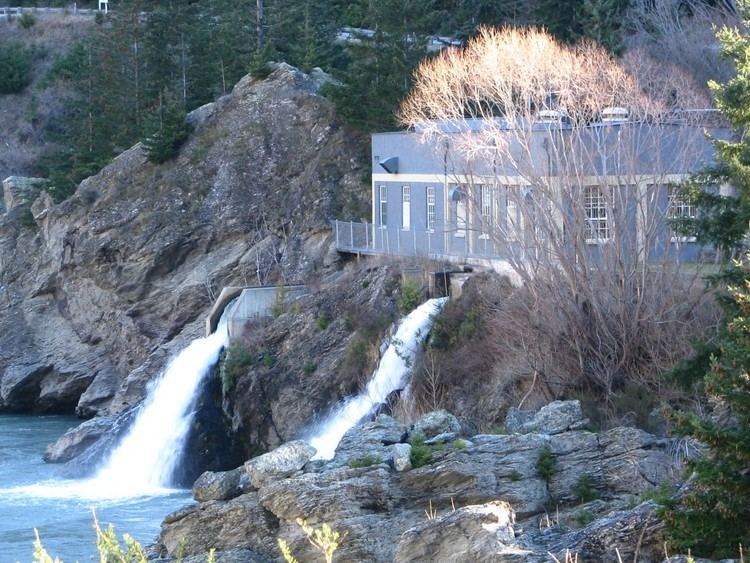 | ||
Hydroelectric power in New Zealand has been a part of the country's energy system for over 100 years and continues to provide more than half of the country's electricity needs. Early schemes such as the Waipori scheme commissioned in 1903 and the Lake Coleridge power station commissioned in 1914 established New Zealand's use of renewable hydro energy.
Contents
By the early 1950s, over 1,000 megawatts (1,300,000 hp) of installed capacity was from hydro energy. By the early 1960s, most North Island hydro sites had been developed while the South Island still had many potential sites. The commissioning of the HVDC Inter-Island link in 1965 made it possible to send large amounts of electricity between the two islands, and from that time hydro capacity in the South Island increased rapidly. Major developments included the 540 MW Benmore Power Station (1966), the 700 MW Manapouri power station (1971), the 848 MW Upper Waitaki River Scheme (1977–85) and the 432 MW Clyde Dam (1992). By the mid-1990s, hydro capacity had reached over 5,000 MW, and remains around this level today.
In 2014, hydro generation produced 24,094 gigawatt-hours (86,740 TJ) of electricity, representing 57% of the total electricity generated. The percentage of New Zealand's electricity provided by hydro generation has been between 50% and 60% for the last decade, compared with a high of 84% in 1980.
History
The first industrial hydro-electric power plant was established at Bullendale in Otago in 1885, to provide power for a 20 stamp battery at the Phoenix mine. The plant used water from the nearby Skippers Creek, a tributary of the Shotover River.
Reefton was the first town with a reticulated public electricity supply from a significant hydroelectric plant after the commissioning of the Reefton Power Station in 1888. They were followed by Stratford in 1890.
The first hydro-electric power station constructed by the government was the Okere Falls Power Station near Rotorua. The plant began operating in May 1901. Electricity was transmitted at 3300 volts over a 13-mile (21 km) route to Rotorua, and was used to drive sewage pumps, and some public buildings including five thermal baths.
During the next twenty years private companies and local authorities established a number of stations, including Waipori in Otago and Horahora on the Waikato River. The first large scheme developed by the government was Coleridge in Canterbury, opened in 1914. Other significant early stations include Mangahao (1924), Arapuni (1929) and Tuai (1929), connected to a single North Island grid in 1934, and Waitaki (1935) in the South Island.
The Waikaremoana cascade was completed in the 1940s with Piripāua and Kaitawa stations. A further seven stations were developed as a cascade on the Waikato River from 1953 and 1970. In the 1950s development of the Clutha River with Roxburgh Dam and the upper Waitaki in the MacKenzie Basin with "Tekapo A" was begun.
With commissioning of the HVDC Inter-Island link in 1965, the Waitaki scheme was further expanded with Benmore Power Station (1965), Aviemore Dam (1968), and later Tekapo B, and Ohau A, B and C.
In the North Island, the Tongariro Power Scheme was completed between 1964 and 1983.
The plan in 1959 to raise the level of Lake Manapouri for hydro-electric development was met with resistance, and the Save Manapouri Campaign became a milestone in environmental awareness. Later hydro schemes, such as the last large hydro to be commissioned, Clyde Dam in 1992, were also controversial.
Generation
Hydroelectric power accounts for 11% of the total primary energy usage in New Zealand with imported oil and oil products making up 70% of the primary energy. Hydroelectric power accounts for 57% of the total electricity generation in New Zealand.
Over the decade from 1997 hydroelectric power as a percentage of total net electricity generated went from 66% down to 55%. An increase in coal and gas for electricity generation accounted for the reduction in hydroelectric power as a percentage of the total.
Large hydroelectric power schemes have been built in the Central Plateau region of the North Island and in the MacKenzie Basin in the South Island, as well as a series of power stations on the Waikato River.
Proposed projects
There are a number of proposed hydroelectric power projects in New Zealand and, despite the demand for more renewable energy, there is opposition to some new hydroelectric projects.
Other proposals, at various planning stages, include schemes on the Matakitaki, Matiri, Waimakariri, Clutha, Kaituna and the Gowan Rivers.
Environmental issues
There has been opposition to hydroelectric power on environmental grounds for many decades.
The first nationwide environmental campaign in New Zealand was opposition to raising Lake Manapouri for a power station to supply electricity to an aluminium smelter. The Save Manapouri Campaign was a success and the power station was built without raising the level of lake outside of its natural range.
The highly endangered black stilt, which nests on the braided rivers beds of the South Island, is threatened by changes in river flows as a result of new hydro dams and changes in flow regimes for existing dams. The Upper Waitaki Power Development posed a threat to the black stilt habitat and a programme was set up to lessen the threats. Because of opposition to new HEP stations New Zealand's demand for increased power has been met from coal and gas fired power stations. Engineers have fine tuned some HEP stations such as at Tokaanu to increase output by 20% with the same water use.
